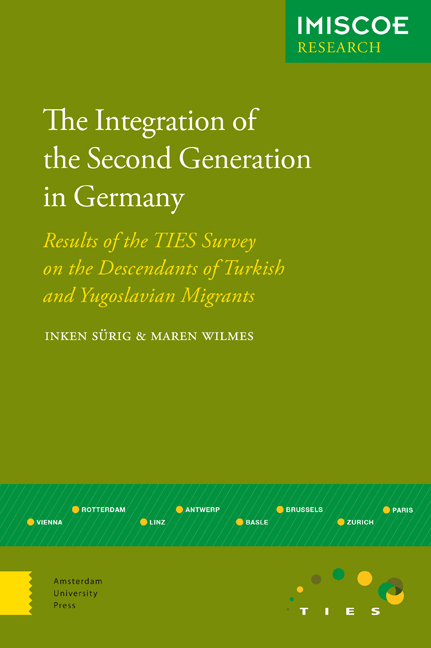 The Integration of the Second Generation in Germany
The Integration of the Second Generation in Germany Book contents
- Frontmatter
- Contents
- Preface: The International Research Project TIES
- 1 Introduction
- 2 Migration History and Basic Demographic Characteristics of the First Generation
- 3 Educational Careers and Educational Outcomes
- 4 Labour Market Positions
- 5 Segregation and Housing
- 6 Ethnic and Cultural Orientations
- 7 Social Relations
- 8 Family Formation and Partner Relationships
- 9 Conclusions and International Comparisons
- References
- Other IMISCOE Research Titles
6 - Ethnic and Cultural Orientations
Published online by Cambridge University Press: 11 December 2020
- Frontmatter
- Contents
- Preface: The International Research Project TIES
- 1 Introduction
- 2 Migration History and Basic Demographic Characteristics of the First Generation
- 3 Educational Careers and Educational Outcomes
- 4 Labour Market Positions
- 5 Segregation and Housing
- 6 Ethnic and Cultural Orientations
- 7 Social Relations
- 8 Family Formation and Partner Relationships
- 9 Conclusions and International Comparisons
- References
- Other IMISCOE Research Titles
Summary
Introduction
In the previous chapters, the descendants of Turkish and Yugoslavian immigrants and the control group of Germans without a migration background a priori were treated as distinctive groups based on national origin. Focusing now on the ethnic and cultural orientations of the TIES respondents, definitions and declarations of identity will be scrutinised to discover the role played by ethnic and cultural categories in the self-descriptions of the second generation.
In general, the individual claim to ‘identity’, in terms of identification with social, ethnic, or cultural semantics, has to do with how one seeks to be treated. Individuals are judged in their social context by aspects of the identity they present, and have to bear the consequences of these judgements (Zimmermann 1993). Individual identity is to a great extent formed through identification with social, cultural, or ethnically defined groups, and relevant membership affiliations thus offer orientations towards a ‘collective’ identity (Peters 2003). In the TIES survey, it is the collective identities provided by affiliation with specific ethnic or religious groups that are of interest. It shall be assumed here that, despite a theoretical uncertainty regarding the pragmatic constitution and meaning of collective identities (ibid.), such affiliations provide orientation in modern multicultural society, facilitating definitions of the ‘self’ or the ‘other’.
For the individual, sharing a group identity, whatever form it may take, provides categories with which social reality can be constructed. Moreover, the claim to distinction, be it based on internal or external descriptions, produces distinctiveness. Members and non-members can thus recognise each other by way of specific criteria valid for all members of a particular group (see Radtke 1998; Zimmermann 1993). Ethnic semantics thus not only offer a means of self-identification, but to the same degree provide a means of external ascription. At the same time, both objective and subjective ‘ethnic’ distinctiveness is practically meaningless if it is not made relevant in functional contexts. Yet ethnic semantics are primarily dysfunctional in daily interaction, if they create an idea of irreconcilable differences and thereby thwart successful communication (see Radtke 1996, 1998).
- Type
- Chapter
- Information
- The Integration of the Second Generation in GermanyResults of the TIES Survey on the Descendants of Turkish and Yugoslavian Migrants, pp. 133 - 150Publisher: Amsterdam University PressPrint publication year: 2015


